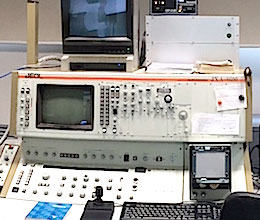Electron Microprobe Laboratories

The electron microprobe allows for qualitative and quantitative chemical analysis on extremely small volumes (of the order of few cubic meters) of prepared solid samples. The electron microprobes in our laboratories analyse elements with atomic number > C with 1-2% precision for major and 5-10% precision for minor and trace elements. The detection limit depends on the characteristics of the analysed element and of its matrix, and can be as low as 30 parts for million (ppm).
Electron microprobe is commonly used in the analysis of geologic materials (mineral, glasses), although its applications ranges from metallurgy to material sciences, from archeometry to medicine and others. Except for sample preparation, consisting in the preparation of a plain and polished surface, the analysis is non destructive.
In the electron microprobe analysis a narrow beam of electrons is focalized on the sample to produce secondary x-rays characteristic of each element.
By measuring the intensity of the X-ray emissions and comparing them with the X-ray emissions intensity of a sample with well known composition (standard) it is possible to determine the concentration each element in the unknown sample once taken into due account all the matrix effects.
